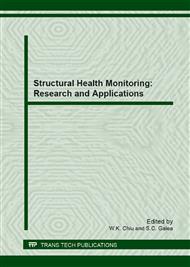p.139
p.149
p.160
p.174
p.184
p.195
p.205
p.218
p.227
Damage Characterisation of Carbon Fibre Reinforced Composite Plate Using Acoustic Emission
Abstract:
Acoustic Emission (AE) is a sensitive technique which can be used to characterise damage in high strength composite plate. This paper describes an extension to an earlier piece of research work carried out by the ERC which resulted in the successful development of a novel source location methodology for the said material. The previous work concentrated on the source location in plate-like composite structures using acoustic emission. The work presented in this paper focuses on establishing the correlation between the different damage types suffered in the material namely de-lamination, matrix cracking, fibre rupture and stringer to skin debonding with key signal features of the AE activities. Controlled bending tests were initially carried out on laterally grooved slender composite specimens to progressively propagate damage in the weakened region of these specimens. The composite laminate plate itself is made from 16 plies of carbon fibre twill weaved in an epoxy matrix with bidirectional fibre alignments in the 0° and 90° directions with 60/40 fibre-matrix volume composition. These prepared samples were fully instrumented with broad band (100 kHz to 1MHz) Physical Acoustic AE sensors linked to the necessary signal conditioning hardware. The AE events were recorded using a high speed DAQ card accessed by customised software written in LabVIEWTM. Gathered raw data were analysed off-line for key signal features including energy and frequency contents and subsequently correlated to actual damage types. It can be concluded from the empirical evidence that feature vectors are distinct to the type of damage. Results gathered from additional test on the progressive skin-stringer debonding of the same material to failure confirmed the uniqueness of the AE feature trends. An integrated system which is capable of both in-situ location of compromised sites and the diagnostic of flaw types in composite plate can potentially find engineering applications including the structural health monitoring of composite aircraft parts.
Info:
Periodical:
Pages:
184-194
Citation:
Online since:
June 2013
Keywords:
Price:
Сopyright:
© 2013 Trans Tech Publications Ltd. All Rights Reserved
Share:
Citation:


